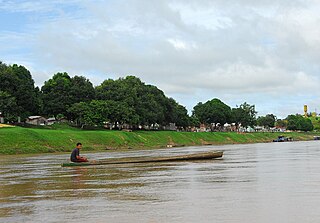People and economy
As of April 2012 there were 422 families in the Rio Gregório Forest Complex, which covered 480,000 hectares (1,200,000 acres) in total. The state's Department of Industry, Trade and Sustainable Services (SEDENS) had a number of plans for the complex. These included providing two new trucks to support the communities, making football fields in each community, providing coordinators to arrange meetings, resuming production of tree seedlings and providing assistance with family farming, small livestock and fish farming. Each family would get a concession of 100 hectares (250 acres) of which 20% could be cleared and the remainder used in a sustainable way. Wood processing factories were to be built in Cruzeiro do Sul and Tarauacá.

Tarauacá is a municipality located in the northwest of the Brazilian state of Acre. Tarauacá has a population of 43,151 people and has an area 20,171 square kilometers (7,788 sq mi).
The Acurauá River (Portuguese: Rio Acurauá is a river of Acre and Amazonas states in western Brazil. It is a tributary of the Tarauacá River.

The Gregório River is a river of Amazonas and Acre states in western Brazil. It is a tributary of Juruá River.
The Riozinho River is a river of Amazonas state in north-western Brazil. It is a tributary of the Jutaí River.

Itaituba II National Forest is a national forest in the state of Pará, Brazil.
Amaná National Forest is a national forest in the state of Pará, Brazil. Most of it has been allocated for use in sustainable forestry or community forestry. Mining is allowed.

The Santa Rosa do Purus National Forest is a national forest in the state of Acre, Brazil.
The Alto Juruá Extractive Reserve is an extractive reserve in the state of Acre, Brazil. The reserve is in the Amazon rainforest. As of 2011 it had about 5,000 residents. The objective is to support traditional occupations including extraction of rubber and other forest resources, farming, hunting and fishing, while preserving the environment.
The Rio Gregório State Forest is a state forest in the state of Acre, Brazil. The main economic activity is latex (rubber) extraction.
The Rio Liberdade State Forest is a state forest in the state of Acre, Brazil.
The Antimary State Forest is a state forest in the state of Acre, Brazil. It was the first state forest in Acre, established with the goal of understanding and implementing sustainable forest exploitation, including extraction of nuts and rubber as well as selective extraction of timber. It has been extensively studied and discussed internationally as a model of sustainable forest management.
The Alto Tarauacá Extractive Reserve is an extractive reserve in the state of Acre, Brazil.
The Rio Gregório Extractive Reserve is an extractive reserve in the state of Amazonas, Brazil. It supports about 200 families engaged in extraction of forest products, small-scale farming and animal husbandry.

The Ituxi Extractive Reserve is an extractive reserve in the state of Amazonas, Brazil.
The Rio Amapá Sustainable Development Reserve (Portuguese: Reserva de Desenvolvimento Sustentável do Rio Amapá is a sustainable development reserve in the state of Amazonas, Brazil.
The Igapó-Açu Sustainable Development Reserve is a sustainable development reserve in the state of Amazonas, Brazil. It is part of a "green barrier" created to prevent deforestation along the BR-319 highway.
The Canutama Extractive Reserve is an extractive reserve in the state of Amazonas, Brazil.
The Tapauá State Forest is a state forest in the state of Amazonas, Brazil.
The Rio Madeira Sustainable Yield Forest is a set of managed forests in the state of Rondônia, Brazil. Three sectors, A, B and C, were created in 1990 but only sectors B and C remain. The forests have not been managed in a sustainable manner.
The Purus National Forest is a national forest in the state of Amazonas, Brazil. It surrounds the shamanic-Christian community of Céu do Mapiá.
This page is based on this
Wikipedia article Text is available under the
CC BY-SA 4.0 license; additional terms may apply.
Images, videos and audio are available under their respective licenses.






